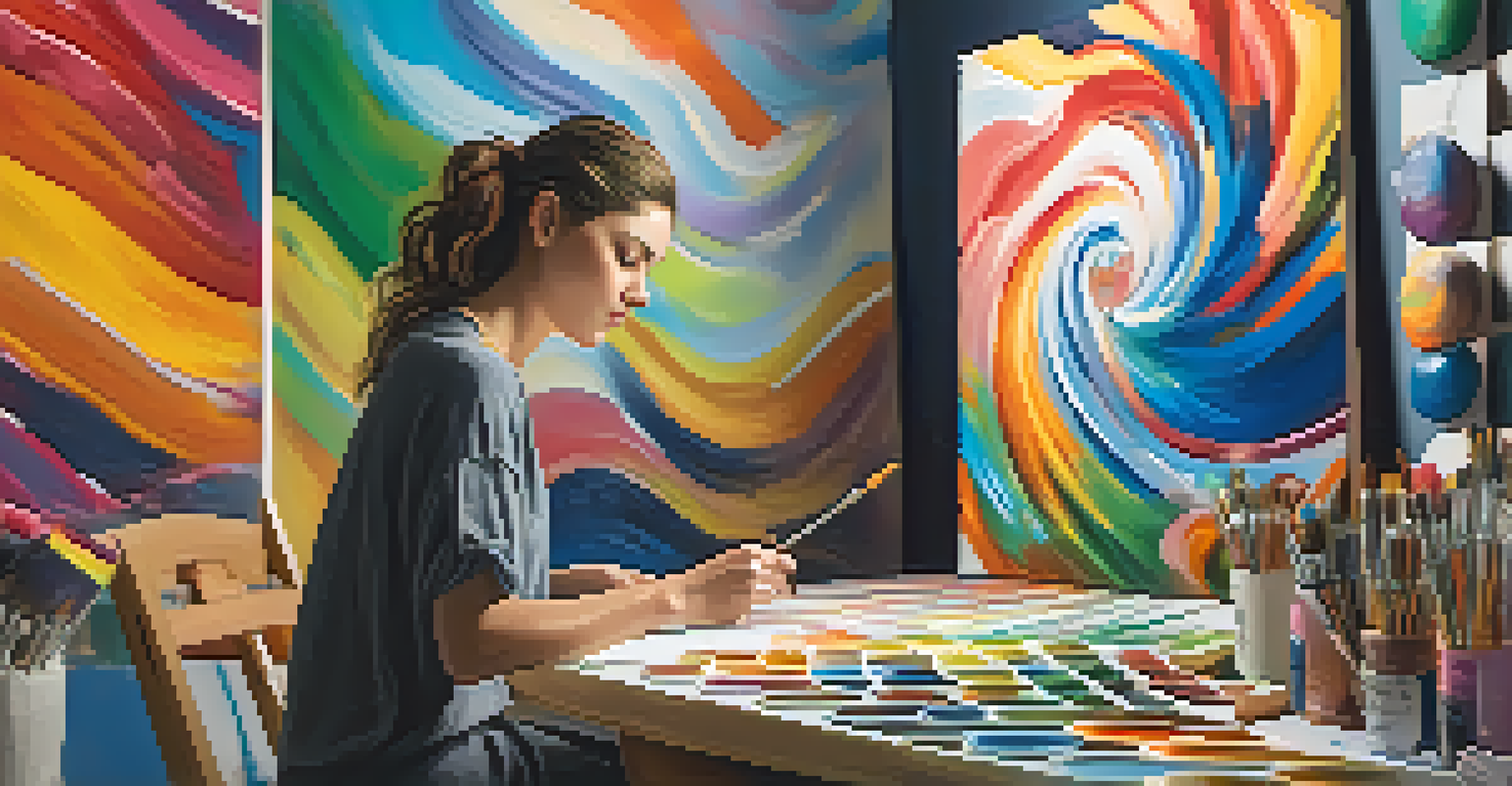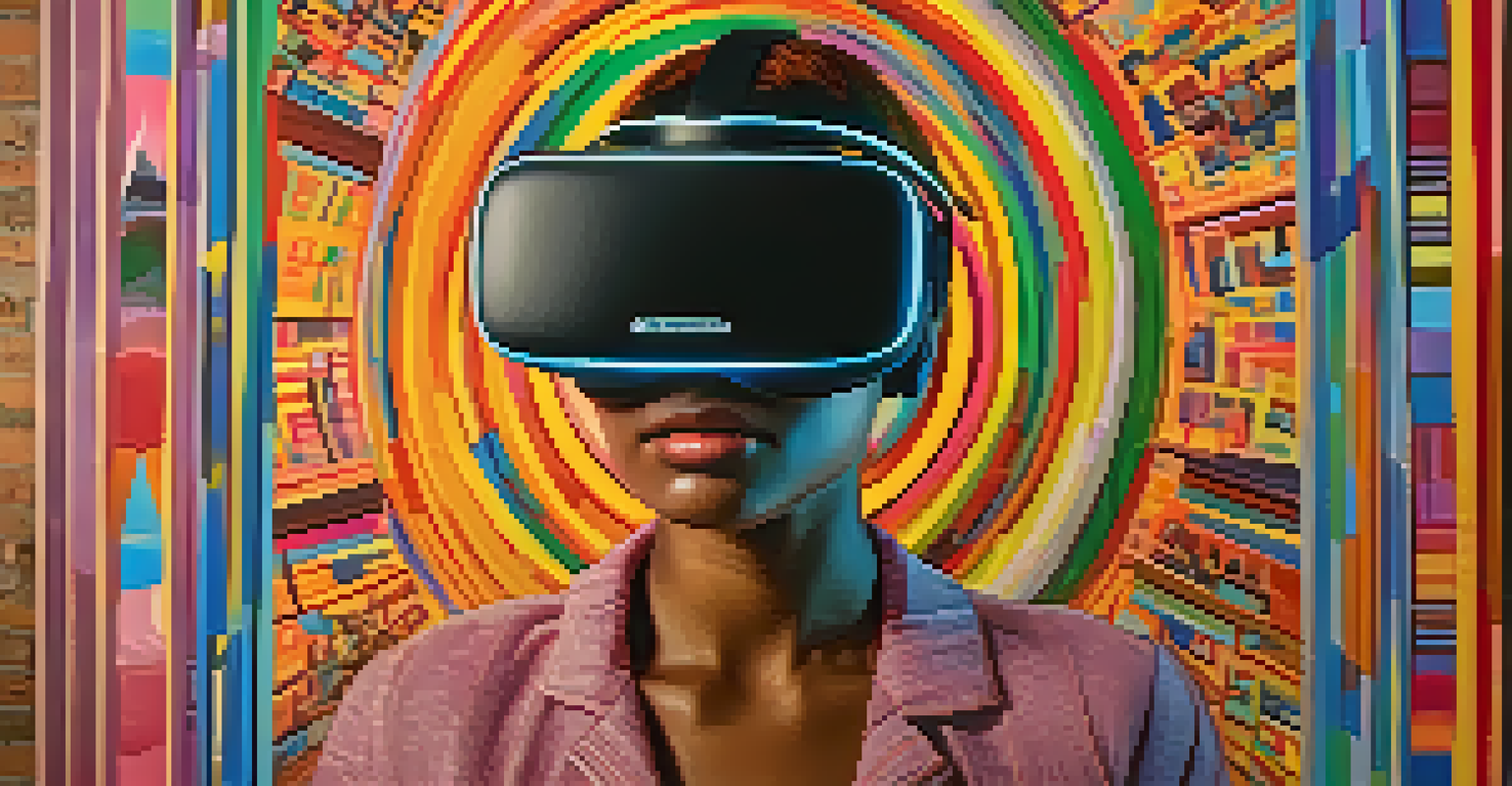Queer Art: A Medium for Expressing LGBTQ+ Identities

Understanding Queer Art and Its Significance
Queer art encompasses a diverse range of creative expressions that reflect LGBTQ+ identities and experiences. It serves not only as a form of artistic expression but also as a crucial tool for political activism and social commentary. Artists use their work to explore themes of identity, love, and the struggle for acceptance, often challenging societal norms in the process.
Art is not a mirror to hold up to society, but a hammer with which to shape it.
This art form is deeply rooted in history, emerging prominently during the LGBTQ+ rights movements of the late 20th century. It has evolved into a vibrant scene, showcasing everything from visual arts to performance pieces. The significance of queer art lies in its ability to create a sense of belonging and representation for those within the community.
By engaging with queer art, audiences can gain insight into the rich tapestry of LGBTQ+ experiences. It opens up dialogues about sexuality, gender, and identity, fostering understanding and empathy. In this way, queer art is not just about aesthetics; it's a vital means of storytelling and connection.
The Role of Queer Art in Identity Exploration
Queer art plays a pivotal role in helping individuals navigate their identities. For many artists, creating is a way to explore their feelings, experiences, and the complexities of their lives. This exploration can be therapeutic, allowing them to confront personal challenges and societal expectations through their art.

For instance, an artist may depict their journey of self-acceptance through vibrant colors and abstract forms, capturing the chaos and beauty of their experiences. This not only provides catharsis for the artist but also resonates with others who have faced similar struggles. In essence, queer art becomes a mirror reflecting the myriad facets of identity.
Queer Art as Identity Exploration
Queer art serves as a therapeutic medium for individuals to navigate and reflect on their complex identities and experiences.
Moreover, the process of creating and sharing queer art fosters community. When people see their experiences represented, it reinforces the idea that they are not alone. This sense of solidarity is crucial, especially for those who may feel marginalized or isolated in their daily lives.
Challenging Norms: Queer Art as Activism
Queer art often serves as a form of activism, challenging societal norms and advocating for LGBTQ+ rights. Artists use their platforms to address issues such as discrimination, inequality, and violence against the community. Through provocative imagery and powerful messages, they spark conversations that demand attention and action.
The role of the artist is to make the revolution irresistible.
For example, street art and murals can transform public spaces into platforms for resistance. These works can critique political systems, highlight injustices, and celebrate LGBTQ+ history and culture, all while reaching a broad audience. This accessibility is a key strength of queer art, as it invites everyone to engage with important social issues.
Additionally, queer art can help to humanize the struggles faced by the LGBTQ+ community. By presenting personal stories and experiences, artists provide a counter-narrative to stereotypes and misconceptions. This not only educates the public but also fosters empathy and understanding, paving the way for a more inclusive society.
The Impact of Digital Platforms on Queer Art
In today's digital age, online platforms have transformed how queer art is created, shared, and consumed. Social media allows artists to reach global audiences, breaking down geographical barriers that once limited exposure. This democratization of art has led to a flourishing of diverse voices and styles within the queer community.
Artists can share their work instantly, engage with followers, and build communities around their art. Platforms like Instagram and TikTok have become vital spaces for queer expression, where artists can showcase everything from digital illustrations to performance art. This accessibility has empowered many to share their stories and connect with others who resonate with their experiences.
Activism Through Queer Art
Artists utilize queer art to challenge societal norms and advocate for LGBTQ+ rights, sparking important conversations about discrimination and equality.
Moreover, the internet serves as an archive, preserving queer art history that might otherwise be overlooked. Online galleries and virtual exhibitions provide spaces for marginalized artists to display their work, ensuring that diverse narratives are represented and celebrated. As technology continues to evolve, so too does the landscape of queer art.
Exploring Intersectionality Through Queer Art
Intersectionality is an essential concept in understanding queer art, as it acknowledges the overlapping identities that shape individual experiences. Many queer artists explore how race, gender, class, and sexuality intersect within their work, highlighting the complexity of their identities. This approach enriches the narrative of queer art, making it more inclusive and representative.
For instance, an artist who identifies as both queer and a person of color might incorporate elements from their cultural heritage into their artwork. This blending of identities allows for a more nuanced exploration of their experiences and challenges societal stereotypes. By embracing intersectionality, queer art can address broader social issues while remaining deeply personal.
Furthermore, this focus on intersectionality encourages dialogue within the LGBTQ+ community itself. It prompts discussions about privilege, representation, and the unique challenges faced by individuals at the intersections of various identities. In doing so, queer art fosters a more inclusive understanding of what it means to be part of the LGBTQ+ community.
The Future of Queer Art: Trends and Innovations
As society continues to evolve, so does the realm of queer art. Emerging trends reflect the changing landscape of LGBTQ+ identities and experiences, often incorporating technology, multimedia, and interactive elements. This innovation keeps the art form dynamic and relevant, allowing it to adapt to contemporary issues and dialogues.
One notable trend is the rise of digital art forms, such as virtual reality and augmented reality experiences. These technologies offer immersive ways to engage with queer narratives, inviting audiences to step into the artist's world. Such innovations not only enhance the viewer's experience but also expand the boundaries of what queer art can be.
Digital Platforms Transform Art
The rise of digital platforms has revolutionized how queer art is shared and consumed, enabling a broader reach and greater representation of diverse voices.
Additionally, queer art is increasingly being recognized in mainstream art spaces, with galleries and museums dedicating exhibitions to LGBTQ+ artists. This visibility is crucial for fostering appreciation and understanding of queer art's significance. As these trends continue to develop, the future of queer art promises to be vibrant, diverse, and transformative.
Celebrating Queer Art as a Collective Experience
At its core, queer art is about celebration—celebrating identities, experiences, and the resilience of the LGBTQ+ community. Art events, pride festivals, and exhibitions allow for collective experiences that bring people together, fostering a sense of unity and belonging. These gatherings create safe spaces where individuals can express themselves freely and authentically.
Moreover, celebrating queer art encourages individuals to embrace their uniqueness and share their stories. By showcasing diverse artists and their work, these events highlight the richness of the LGBTQ+ experience. This celebration not only empowers artists but also inspires audiences to engage with and support queer art.

Ultimately, queer art serves as a reminder of the power of creativity in building community and promoting understanding. As we celebrate the contributions of queer artists, we also recognize the importance of their voices in shaping a more inclusive future. In this way, queer art becomes a testament to the strength and diversity of the LGBTQ+ community.